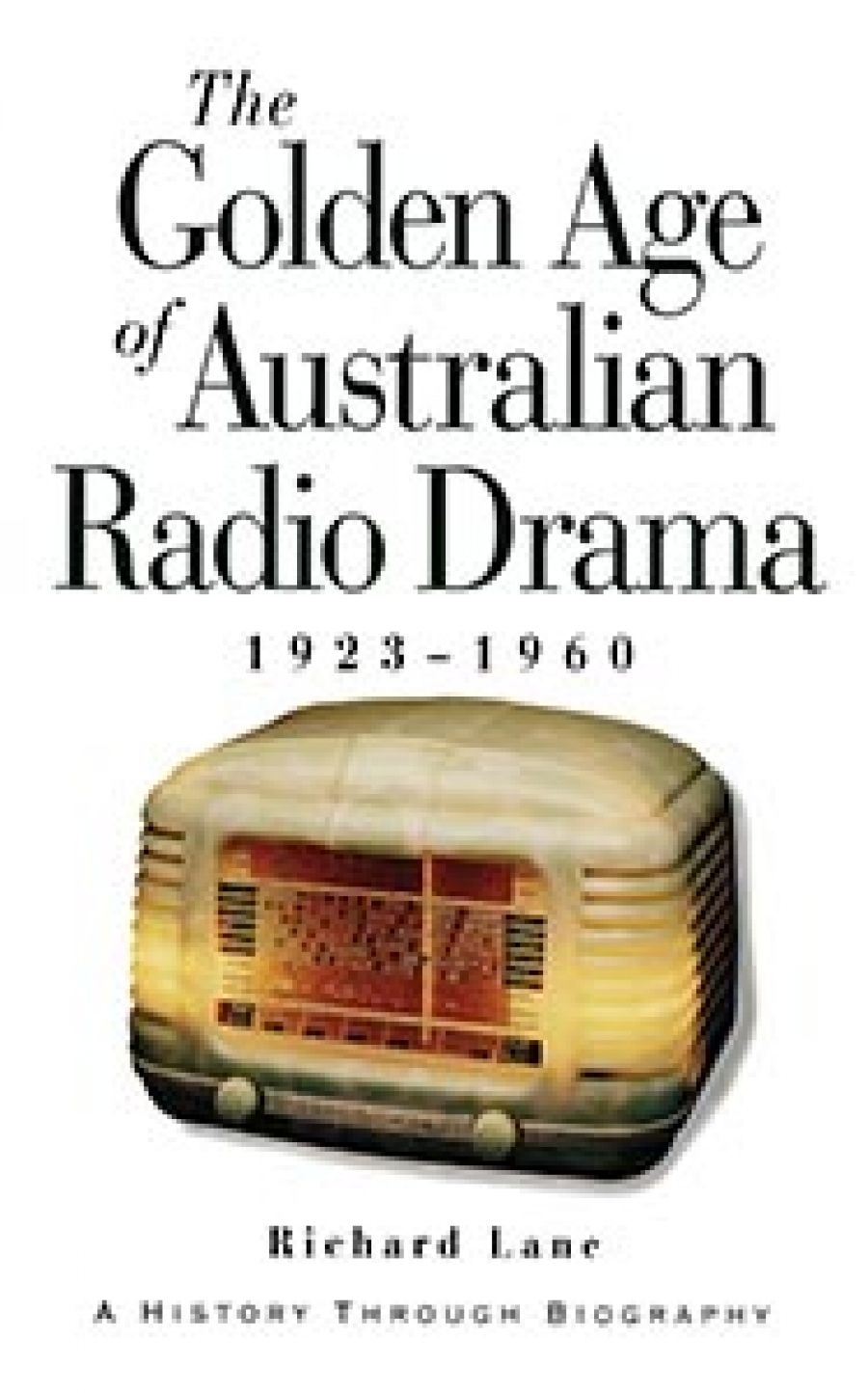
- Free Article: No
- Review Article: Yes
- Article Title: Halcyon Radio Days
- Online Only: No
- Custom Highlight Text:
In recent times, we hear, stars of TV serials such as Neighbours and Home and Away have been mobbed on arrival at Heathrow Airport, and recognized even in Finland – Australian production houses appear to have a talent for capturing on screen alluring fantasies and traumas for purveying to mass audiences, both home and away. The foundations for this sorely-needed export industry were doubtless laid in the 1940s and 50s, when Australian radio serials and drama were heard around the globe, at least in English-speaking countries (subtitles are difficult on radio). At home, hundreds of hours of drama were pumped out every year on ABC and commercial stations ...
- Book 1 Title: The Golden Age of Australian Radio Drama, 1923–1960
- Book 1 Subtitle: A history through biography
- Book 1 Biblio: MUP $49.95pb
On this period of extraordinary productivity for Australian writers, producers, actors and, technical people, very little has been written so far, apart from sections of This is the ABC by Ken Inglis and Out of the Bakelite Box by Jacqueline Kent. A critical history could be a fascinating document: just how good were all those thousands of plays, now disappeared forever into the ether, what values did they embody, how did they compare with the films and plays of the period? This book is not that critical history and does not pretend to be, but it will be an indispensable reference book for anyone working in the field for years to come. Here are ‘biogs’ of over 100 leading characters in radio drama: the English actor-managers, the comedy duos, the frenetic-paced producers, the hacks, and the poets, the rival queens of the serials. Some of the big names in radio retained them by achieving fame in other areas: Peter Finch, Morris West, Patricia Kennedy, John Meillon; some of the biggest names of the Golden Age are not widely remembered now outside the radio business: Lawrence H. Cecil, Frank D. Clewlow, Lyndall Barbour, George Edwards, Neva Carr Glyn, Catherine Duncan, John Nugent Hayward – these were some of the giants, some of them ‘written up’ in this book for the first time. Many of them were personally known to Richard Lane during a long career writing and producing for radio, and he has drawn on his own records and recollections, as well as extensive interviews with their friends and colleagues. In drawing all this together, he has performed an invaluable service. The result is a collection of pieces of various lengths (one to six pages) combining chat with credits, impressions with facts – fascinating for anyone with an interest in Australian drama and cultural history, though liable to bring on indigestion if swallowed in too large doses.
This will give the flavour:
In drama, Patricia Kennedy’s first big break came in January 1940 when Harry Dearth cast her in the star role of Moonyean in Smilin’ Through for the Lux Radio Theatre, with John Nugent Hayward and John Tate in the leading male roles. Listeners voted this the most popular play in Lux’s first year on air. In 1941 she gave performances for the ABC that stamped her beyond dispute as one of radio’s finest actresses.
And so it goes on – interesting segments, hard to digest in quantity, as with most reference books no doubt. At his most impersonal (infrequently), Richard Lane becomes dry, but I was more irritated by a tendency to gush: ‘... Lyndall Barbour and Ailsa Grahame … shared some of the most superb scenes of restrained tragic emotion ever heard on radio.’ And he has some of his stars all too neatly pinned down in phrases: ‘(Neva Carr Glyn) was a darkhaired beauty with an often imperious manner’; ‘Dinah (Shearing) quickly became an integral part of the radio world with her flute-like voice, warm winning personality, bright chatter and desire to excel.’ I fear that Ms Shearing will exclaim in non-flute-like tones on reading that. Despite the wealth of stories and information in the book, Lane is not the most entertaining gossip – a touch of Oscar Wilde or Truman Capote would have gone a long way. Still, the writing skill that enabled Lane to turn out dozens of plays and serials has far from deserted him.
This is a lovely book to browse in, but for a reference work, it’s rather difficult to look up. If you want to find, say Leslie Rees, you would have to know that he worked for the ABC and was associated with other ABC identities of the 30s and 40s such as Frank D. Clewlow, Ida Osbourne (Jenkins), Max Afford, and Alexander Turner, for this group is bracketed under Part One, III, A Federal Productions Department for the ABC – or you could simply head for the index. To avoid listing his notables alphabetically, Lane has placed them in groups according to production houses and periods – not a bad idea, except that there is so much overlapping that the groupings become confusing, especially for the novice to the field. Despite these weaknesses, this is a celebration of a remarkable and largely forgotten era.
It was mean of Lane (and I hope inaccurate) to take a swipe at continuing ABC radio drama: ‘The few esoteric plays produced after that (early 80s) by ABC Radio for minimal audiences bore no relationship to the radio drama we knew during its great years ...’. We may be well out of the Golden Age, but a department which can win the Italia Prize for radio drama twice in four years (1991 and 1994) must be doing something right.


Comments powered by CComment